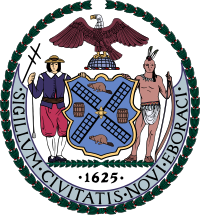Seal of New York City
The seal of New York City was adopted in an earlier form as early as 1686 and is labeled SIGILLUM CIVITATIS NOVI EBORACI , which simply means "The Seal of the City of New York": Eboracum was the Roman name for York, the titular seat of James II as Duke of York , Civitas Novi Eboraci is the latinized name of the city.
The coat of arms depicts four wings of a windmill to commemorate the city's Dutch history as Nieuw Amsterdam . The beavers and flour barrels mark the city's first merchandise. The flour barrels and windmill also represent the enormous wealth that the Bolting Act of 1674 generated for the city. The law gave the city an exclusive monopoly on milling and flour exports.
The two shield holders represent the unity between the native American Indians and the colonists . The colonist to the left of the shield is a seaman and has a plumb line in his right hand. A Jacob's staff is depicted over his right shoulder . To the right of the sign is a member of the Lenni Lenape Indian tribe who lived in Manhattan . He is holding a bow in his left hand . The shield and the shield holder stand on a horizontal branch of laurel.
A bald eagle , which was added after American independence , is depicted as a helmet jewel above the seal . The year the city was founded is indicated at the bottom with 1625 . A laurel wreath surrounds the seal almost all around.
Web links
- Flag and seal of the city , Department of Citywide Administrative Services, New York City
